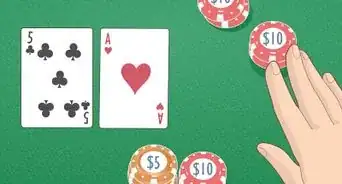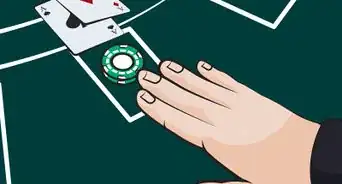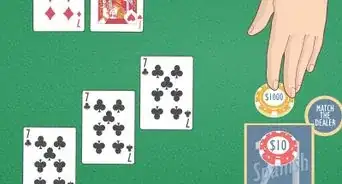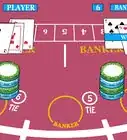wikiHow is a “wiki,” similar to Wikipedia, which means that many of our articles are co-written by multiple authors. To create this article, 68 people, some anonymous, worked to edit and improve it over time.
There are 13 references cited in this article, which can be found at the bottom of the page.
This article has been viewed 863,234 times.
Learn more...
Blackjack is a simple card game that has more players than roulette, craps, and baccarat combined.[1] Blackjack is mainly a luck and chance game, but also a strategy game. You too can have a dalliance with lady luck on one of the most popular casino games on the planet.
Steps
Blackjack Help
For the True Beginner
-
1Learn the value of the cards. In Blackjack, each card has a value that remains constant throughout the game.[2] The goal is to beat the dealer and also not bust with a 22 or more. Here are their values:
- Number cards: The number is the value of the card.
- Face cards: The value of face cards is 10.
-
Ace: Either 1 or 11. It is counted as 11 (...generally) unless it would put you over 21, in which case it counts as 1.
- Therefore, an ace and a ten card are 21 in two cards, which is Blackjack/Natural.
- A hand containing an ace is called "soft" hand.
-
2Learn your choices: There are two basic options when it's your turn:[3]
- Hit: Get another card. You are able to hit until you go over 21.
- Stand: Keep your current cards and do nothing. You do not receive more cards.
- There are also a few extra possibilities you can use for certain hands:
- Taking insurance: This is only available when the dealer is showing an ace. You place a new bet that will then pay at 2-1 if the dealer does indeed have a blackjack. You lose your other bet (which would pay 1-1) but win the insurance, resulting in breaking even.[4]
- Double Down: You double your bet, and get only one more card. This is generally only used when your initial two cards equal 8-11 or soft 12 to soft 19.[5]
- Split: Make two hands from one hand, if both cards are the same value. Tens, Jacks, Queens, and Kings are usually counted as 10 each. If both of your hands win, you get double the amount of money. If only one wins, you break even. If both hands lose, you lose double the money. Split the hands by separating the cards and placing a duplicate bet.[6]
-
Surrender: In many casinos, you can (before playing and after determining if the dealer has a blackjack) choose to give up half of your bet without playing.[7]
Surrender is only desirable when the dealer is showing a 9-A, and the player has a 5-7 or 12-16.
- When the dealer has an ace, he or she automatically checks to see if a blackjack is had. Early surrender is when you opt out of half your bet before the dealer checks for a blackjack on their behalf.[8]
Advertisement -
3Start winning. In order to win, the player has to be closer to 21 than the dealer, without going over. If the player goes over, he has "busted." If it's a tie, it's a "push" -- neither the player nor the house wins. A blackjack is when your starting hand is an ace and 10, or face card.[9]
- The dealer will go around the players until each one decides to stand. they then play their own hand, which determines the outcome of the game. Obviously, each hand is different. Generally, players using copy the dealer hit on 16 or less. This is a bad strategy. The never bust strategy is a little better, but it is still a bad strategy.[1]
- The casino's greatest advantage (the "house edge") is that the player has to act first. If a player "busts" (goes over 21), the casino immediately takes the player's money. If the casino then "busts" on the same hand, the player still loses. The dealer is the last one to play the hand.
Rules & Strategy
-
1Understand the "House rules." Most casinos always "stand" on 17 and greater. Some will "hit" a "soft 17" (any 6 and an ace). Some casinos (though rarely) require an "ante" like in poker (play in those casinos favors the house as much as 20%). You'll quickly gather your casino's rules when you sit down to play.
- Casinos have varying rules on insurance, splitting, and doubling down when it comes to how and when you can do it. Your dealer will surely let you know it if comes to this. For example, some casinos won't let you split a third Ace; for surrendering, some abide by early or late surrender only.[1]
-
2Recognize the implications of insurance, splitting, doubling down and surrender. All of the extra actions favor the house when used incorrectly -- it wouldn't be a casino game if the opposite were true!
- When making an insurance bet,[10] you are betting that the dealer's hole card is a 10, Jack, Queen or King. There are 13 potential ranks of cards in the deck. You have less than a 1 and 3 chance of it paying. The best time to make an insurance bet is when the count is (whatever you found it to be.) If the dealer turns out to have a blackjack, you will have a "push" (tie) with the dealer; your insurance bet will pay 2-1 which pays better than the original bet of 3-2!
- When doubling down, you only get one card.[11] You may not like the hand you end up with. In fact, that is what the casino is counting on! Never double down if the dealer is an ace or a face card (unless you have 11).
- Splitting can turn an excellent hand into a terrible one, and vice versa.[12] Here are some rules of thumb: Never split 5's -- your total is 10; you are likely to end strong. Always split 8's and Aces. Splitting 8's will change probable losers to probable winners. Splitting Aces is advantageous, but understand this: You are only allowed to split Aces once (sometimes), and you can only take one card for each new hand (sometimes.) Some casinos did this because splitting Aces, without any restriction, is a great advantage.
- Once you have "surrendered" your hand, the dealer's actions are unimportant (to you). If the dealer's hand goes sour, you have already given up.
-
3Understand card counting.[13] You're not literally counting the value of all the cards. What some players do (when they're really good) is count the "value" of the deck, or, more specifically, how many aces and tens are left to be played (or this and that.) If lots are still to be seen, they up their bets, knowing the likelihood of them getting a good hand is better.
- Casinos have caught onto this however, and most now use multiple decks in the shoe or cut the deck or both. With six decks in play and more cards taken out, it's not likely with low penetration to track the number of good cards in the deck.
- Because of this, card counting will not be outlined here. Refer to wikiHow's card counting page if you're interested in the details.
- Casinos have caught onto this however, and most now use multiple decks in the shoe or cut the deck or both. With six decks in play and more cards taken out, it's not likely with low penetration to track the number of good cards in the deck.
Casino Play & Etiquette
-
1Grab a seat at an open table. When the hand is over (if you're not alone at the table), whip out your stack of money and tell the dealer what denomination of chips you'd like. (S)He will take your money and exchange it for a pile of chips. Then, you place your bet in the betting box and away you go!
- If you're a newbie to the blackjack game, you may want to avoid the seat on the far left of the table (third base.) Since this is the spot that comes right before the dealer, you're likely to get a lot of heat if you're the reason the dealer turns up a 5, or any good card for themselves, though you may be congratulated if you make the dealer bust. Though obviously not logical, no one said humans, and gamblers especially, ever were.[1]
-
2Start using your hands. At a casino's blackjack table, being mute would go entirely unnoticed. You don't need a single word to play the game. In fact, you'd blend into the crowd more if you never opened your mouth.
- For hitting, either tap the table with a finger or two or scrape the table with the edge of your cards. For standing, place your chips on top of your cards, face down or wave your hand palm down horizontally over your cards. For splitting, add another bet and point 2 fingers. For doubling down, add another bet to your betting box and point 1 finger.[1]
-
3Assume the dealer has a ten. When it comes down to it, that card facing down has better odds of being a ten (or worth 10) than any other value. If he or she is showing a 6 or lower, the idea is they'll bust. That's the basic strategy.
- You should take into account both your cards and their cards. If you have sixteen and the dealer is showing a six, stand. They have to take a card unless the have an A. But if you have sixteen and the dealer is showing a 7...well, that decision is up to you. If you're alone at a table or with a friendly group, people and/or the dealer will probably be happy to give you advice if you ask.
-
4Know when to walk away. Just like in poker, blackjack has hot and cold tables. It doesn't take a pro to be able to recognize this -- you'll know when you're running out of chips! If you're observant, you'll probably be able to tell which table is running hot just by watching.
- A good rule of thumb is to up your bet in increments. If you win two $5 bets and then lose a $10 bet, you're still even! When your winning streak stops, resume your initial minimum bet until the table goes hot again.
-
5Basic rules of thumb are to always stand hard 17 and over, never stand a soft 17, double soft hands A,2 and A,3 vs 5-6, A,4 and A,5 vs 4-6, and A,6 and A,7 vs 3-6.
Community Q&A
-
QuestionWhen do you place the bet?
 Community AnswerPlace your bet before the cards are dealt. Split, double down, and insurance bets take place after the cards have been dealt.
Community AnswerPlace your bet before the cards are dealt. Split, double down, and insurance bets take place after the cards have been dealt. -
QuestionIf my hand is lower than the other players' hands but beats the dealer, do I win?
 Community AnswerYes. Each of the players is playing the dealer only, not the other players.
Community AnswerYes. Each of the players is playing the dealer only, not the other players. -
QuestionDoes the house almost always deal a 10?
 Community AnswerNot always, but the chances are a lot higher, seeing as every deck, has a 4/13 (16/52) chance of getting a 10.
Community AnswerNot always, but the chances are a lot higher, seeing as every deck, has a 4/13 (16/52) chance of getting a 10.
wikiHow Video: How to Play Blackjack
Warnings
- Do not play while drunk. You will lose your money by doing silly things with your hand.⧼thumbs_response⧽
Things You'll Need
- A deck or more of playing cards with no jokers (if not at a casino, which has plenty)
- Money (if you're going to bet)
- ID (if betting at a casino)
References
- ↑ 1.01.11.21.31.4http://entertainment.howstuffworks.com/how-to-play-blackjack1.htm
- ↑ https://www.blackjack.org/blackjack-rules/
- ↑ http://www.hitorstand.net/strategy.php
- ↑ https://www.gamblingsites.com/blog/taking-insurance-in-blackjack-4759/
- ↑ https://www.gambling.com/online-casinos/strategy/blackjack-strategy-when-to-double-down-23100
- ↑ https://blog.betway.com/casino/blackjack-strategy-101-how-do-you-split-in-blackjack/
- ↑ https://www.blackjackinfo.com/blackjack-school/lesson-24-understanding-the-surrender-option/
- ↑ https://www.gamblingsites.org/casino/blackjack/surrender/
- ↑ https://www.888casino.com/blog/blackjack-strategy/tips-on-how-to-win-at-blackjack
- ↑ https://www.onlinegambling.com/casino/blackjack/insurance-bet/
- ↑ https://blog.betway.com/casino/blackjack-strategy-101-how-do-you-double-down-in-blackjack/
- ↑ https://blog.betway.com/casino/blackjack-strategy-101-how-do-you-split-in-blackjack/
- ↑ https://www.youtube.com/watch?v=G_So72lFNIU
- ↑ https://www.onlineblackjackrealmoney.org/vegas-blackjack-casinos/ballys
- ↑ https://www.forbes.com/sites/davidschwartz/2018/07/16/blackjacks-rise-and-fall-shows-what-drives-customers-away/#315133e52d5e
About This Article
The goal of Blackjack is to have a hand that totals higher than the dealer’s, but doesn’t total to higher than 21. If your hand totals higher than 21, it is called a “bust”, which means you are out of the game. The game starts with everyone besides the dealer placing a bet. Then, the dealer deals 1 card face up to each player and 1 card face up to themselves. Everyone is dealt one more face-up card besides the dealer, whose second card is dealt face down. Cards 2 through 10 are scored using their face value, and Jacks, Queens, and Kings are all equal to 10. Aces can be either 1 or 10, and you can choose their value throughout the round if you have one. If your two face-up cards total 21, you automatically win one and a half times your bet from the dealer, and you’re done for that round. Otherwise, the dealer asks whether you want another card from the top of the deck. If you do, say “hit” or motion toward yourself with your hand. There’s no limit to how many cards you can ask for, but once your hand totals higher than 21, you bust and the dealer gets your bet. If you don’t want any more cards, say “stay” or wave your hand over the table. Once the dealer has gone around the table, they flip up their face-down card. If it’s 16 or under, they have to take another card. If it’s 17 or higher, they have to stay with their hand. If the dealer busts, every player that’s still in that round wins twice their bet. However, if the dealer doesn’t bust, only the players whose hands are higher than the dealer’s win twice their bet. Everyone else loses their initial bet. Once the round is over, all of the players place a new bet, and another round begins. If you want to learn strategies to win blackjack or proper casino etiquette while playing, keep reading!



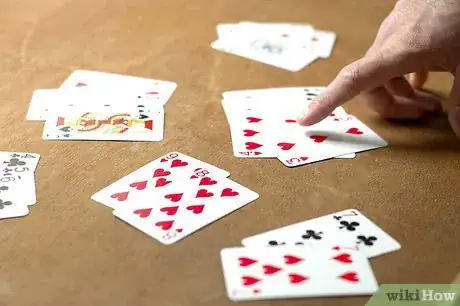


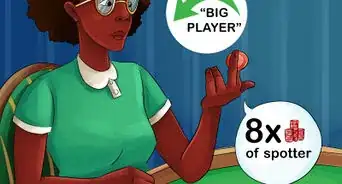


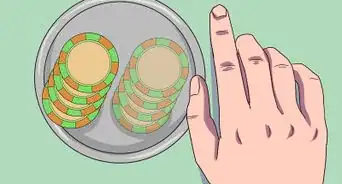
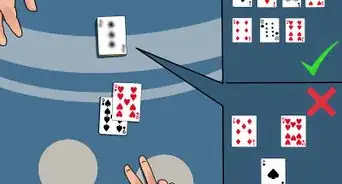
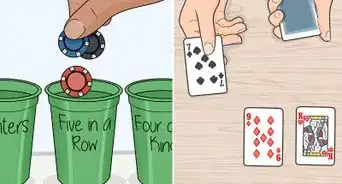
-Step-25.webp)
